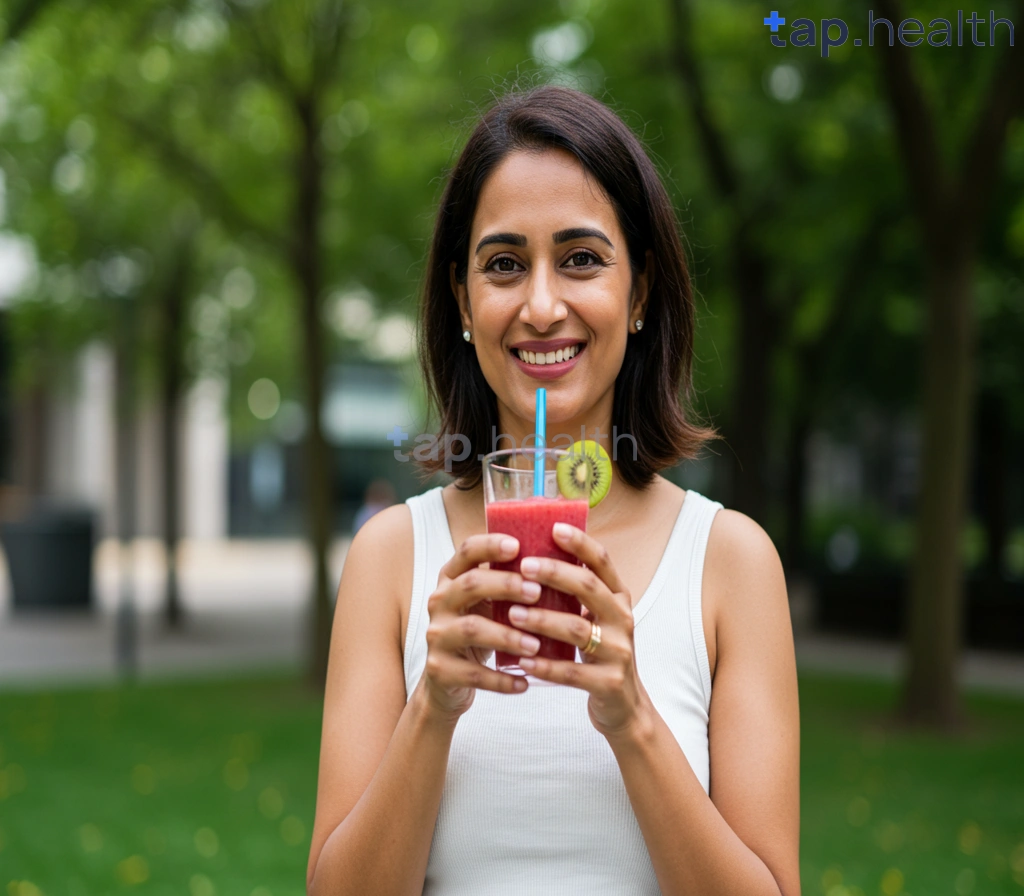Table of Contents
- Diabetes-Friendly Smoothies: Best Fruit Recipes
- Delicious & Healthy Fruit Smoothies for Diabetics
- Top 5 Fresh Fruit Smoothies for Blood Sugar Control
- Easy Diabetes-Friendly Smoothie Recipes Guide
- Create the Perfect Diabetic-Friendly Fruit Smoothie?
- Frequently Asked Questions
- References
Craving a refreshing and healthy treat that won’t spike your blood sugar? Then you’ve come to the right place! This blog is all about Diabetes-Friendly Fresh Fruit Smoothies: Delicious Recipes & Tips. We’ll explore exciting smoothie combinations packed with flavor and nutrients, carefully chosen to help you manage your blood sugar levels effectively. Forget bland, boring diets – we’re here to show you how easy and enjoyable it can be to incorporate delicious smoothies into your daily routine. Get ready to discover your new favorite healthy habit!
Diabetes-Friendly Smoothies: Best Fruit Recipes
Managing diabetes in tropical and Indian climates often means incorporating abundant fresh fruits into your diet. However, the carbohydrate content of fruits needs careful consideration. Generally, a meal should contain around 45–60 grams of carbs for most people with diabetes, but this varies depending on individual needs and should be discussed with your doctor or a registered dietitian. This means choosing fruits wisely and controlling portion sizes is key to creating delicious and healthy smoothies.
Choosing the Right Fruits
Opt for fruits lower on the glycemic index (GI), which means they release sugar into your bloodstream more slowly. Excellent choices readily available across India and tropical countries include: papaya, guava, amla (Indian gooseberry), and berries like strawberries and raspberries (where available). These are naturally lower in sugar and higher in fiber, helping to regulate blood sugar levels. Remember to always check the nutritional information of your chosen fruits. For more information on fruit choices, check out 5 Best Fruits For People with Diabetics – Tap Health.
Delicious Smoothie Recipes
A simple and refreshing recipe is to blend half a cup of papaya, a quarter cup of amla pulp, a handful of spinach (for added nutrients), and a splash of unsweetened almond milk. For a sweeter taste, add a tiny pinch of stevia or a small amount of cinnamon. Another great option combines guava with a squeeze of lime and a few mint leaves. Experiment with different combinations, always keeping portion size in mind to stay within your daily carbohydrate allowance. If you’re interested in exploring other beverage options, you might find 12 Best Juices for Diabetes to Control Blood Sugar Level helpful.
Tips for Success
Portion control is vital. Measure your fruits carefully to manage your carbohydrate intake. Add ingredients like chia seeds or flax seeds for added fiber, which can help slow down sugar absorption. Lastly, always consult with your healthcare provider or a registered dietitian to create a personalized diabetes management plan that includes appropriate smoothie recipes and portion sizes tailored to your specific needs. They can help you determine the best carbohydrate count for your meals and guide you in making the right choices for a healthy and delicious diet.
Delicious & Healthy Fruit Smoothies for Diabetics
Did you know that daily consumption of sugary beverages raises your diabetes risk by 26%? That’s a stark reminder of the importance of mindful beverage choices, especially for those managing diabetes or at risk. Fortunately, you can still enjoy refreshing and delicious smoothies without the sugar spike. The key is choosing the right fruits and incorporating ingredients that help regulate blood sugar levels.
Fruit Choices for Diabetes-Friendly Smoothies
In India and tropical countries, we’re blessed with an abundance of fruits perfect for diabetic-friendly smoothies. Think beyond mangoes and bananas (which are high in natural sugars). Instead, prioritize fruits lower on the glycemic index (GI), such as jamun (black plum), amla (Indian gooseberry), guava, and papaya. These fruits release sugar into the bloodstream more slowly, preventing sudden spikes. Also consider adding a handful of berries like raspberries or strawberries, known for their antioxidant properties and lower sugar content. For more options on low-sugar beverages, check out our guide on Low-Sugar Fruit Juices for Diabetics.
Boosting Your Smoothie’s Benefits
To further enhance your smoothie’s health benefits and help manage blood sugar levels, incorporate ingredients like chia seeds, flax seeds, or a small amount of nuts (almonds, walnuts). These add fiber, healthy fats, and protein, which slow down sugar absorption. A touch of cinnamon is also a great addition, as it’s known to help regulate blood sugar. Remember to control portion sizes – even healthy smoothies should be enjoyed in moderation. And for another healthy snack option, consider adding some dry fruits suitable for diabetics.
Creating Your Perfect Smoothie
Experiment with different combinations! A simple and refreshing option could be a blend of amla, guava, and a few raspberries. For a tropical twist, try papaya, a touch of coconut water (use sparingly due to sugar content), and chia seeds. Remember to always check the sugar content of any added ingredients, such as flavored yogurts or sweeteners, and choose unsweetened varieties whenever possible. Enjoy your delicious and healthy smoothies!
Top 5 Fresh Fruit Smoothies for Blood Sugar Control
Managing blood sugar levels is crucial, especially in regions like India and tropical countries where diabetes prevalence is high. Remember, less than 140 mg/dL is considered normal blood sugar, while 140–199 mg/dL indicates prediabetes, and 200 mg/dL or higher suggests diabetes. These delicious smoothies can help you maintain healthy blood sugar levels:
1. Mango & Coconut Smoothie:
A tropical delight! Mango, while sweet, offers fiber to slow down sugar absorption. Combine ripe mango chunks, coconut water (a natural electrolyte replenisher), and a squeeze of lime for a refreshing and balanced drink. The coconut water adds potassium, beneficial for managing blood sugar.
2. Papaya & Spinach Smoothie:
Papaya is rich in antioxidants and fiber, both important for blood sugar control. Blend papaya, spinach (a good source of nutrients), a few almonds for healthy fats, and a splash of milk (dairy or plant-based). This combination provides a nutrient-packed smoothie.
3. Banana & Cinnamon Smoothie:
While bananas contain natural sugars, the fiber helps regulate their release. Combine ripe banana, cinnamon (known to help regulate blood sugar), and a dollop of Greek yogurt for extra protein. The cinnamon adds a delightful flavor, making this an easy breakfast option. For more natural ways to manage blood sugar, check out our article on Top 8 Natural Remedies to Improve Blood Sugar Levels.
4. Berry Blast Smoothie:
Berries like strawberries, blueberries, and raspberries are low in glycemic index, meaning they cause a slower rise in blood sugar. Blend a mix of your favorite berries with a little chia seeds for added fiber. This is a vibrant and naturally sweet option.
5. Mixed Tropical Fruit Smoothie:
Experiment with a combination of readily available tropical fruits like guava, pineapple, and pomegranate. Remember to moderate the portion size, and balance the sweetness with ingredients like spinach or a squeeze of citrus. This smoothie provides a variety of vitamins and minerals. While these smoothies are great for blood sugar management, maintaining overall cardiovascular health is also important. Learn more about Heart-Healthy Juice Combinations to Support Cardiovascular Health.
Remember to consult your doctor or a registered dietitian for personalized advice on managing your blood sugar levels. Enjoy these delicious and healthy smoothies as part of a balanced diet and active lifestyle! Find fresh, seasonal fruits at your local market to create these recipes easily.
Easy Diabetes-Friendly Smoothie Recipes Guide
Managing diabetes, especially in tropical and Indian climates, requires careful attention to diet. A significant portion of the diabetic population, 61% according to the International Diabetes Federation, falls within the 20-64 age group, a demographic often highly active. Fresh fruit smoothies offer a delicious and convenient way to incorporate vital nutrients while keeping blood sugar levels in check. This guide focuses on creating refreshing and healthy smoothies perfect for the Indian and tropical climate.
Choosing the Right Fruits
Selecting low-glycemic fruits is crucial. While mangoes and bananas are popular, they are relatively high in sugar. Opt instead for fruits like papaya, guava, and berries (strawberries, blueberries, raspberries) which are abundant in these regions and lower on the glycemic index. Adding a handful of leafy greens like spinach or mint, common in Indian cuisine, further enhances the nutritional value and helps slow down sugar absorption.
Recipe Examples
A simple yet effective smoothie could combine ½ cup of papaya, ½ cup of berries, a handful of spinach, and a splash of unsweetened almond milk or coconut water. Another option is a refreshing guava-mint smoothie: blend 1 cup of guava, a few mint leaves, a squeeze of lime, and a small amount of water. Remember to adjust the liquid to achieve your desired consistency.
Tips for Diabetes-Friendly Smoothies
* Portion Control: Stick to recommended serving sizes.
* Fiber Focus: Include fruits with high fiber content to promote satiety and regulate blood sugar. For more ideas on excellent fiber-rich foods, check out 20 Best Foods for People with Diabetes – Tap Health.
* Spice it Up: Add a pinch of cinnamon or cardamom to enhance flavor and potentially improve insulin sensitivity.
* Protein Power: Consider adding a tablespoon of chia seeds or a scoop of protein powder (ensure it’s low in sugar) for sustained energy.
Remember to consult your doctor or a registered dietitian for personalized dietary advice tailored to your specific needs. Enjoy these refreshing and healthy smoothies as part of a balanced diet and active lifestyle, vital for managing diabetes effectively, particularly within the Indian and tropical climate where access to fresh produce is often readily available. For additional tips on managing your diabetes effectively, see 10 Proven Tips to Effectively Manage Diabetes | Simple Guide.
How to Create the Perfect Diabetic-Friendly Fruit Smoothie
For people with diabetes, maintaining a balanced diet is key — and smoothies can be a delicious, convenient way to pack in essential nutrients. However, creating a diabetic-friendly smoothie requires careful ingredient selection to prevent blood sugar spikes. Many fruits are naturally high in sugar and can elevate glucose levels, potentially increasing the risk of complications such as diabetic foot ulcers, which affect nearly 15% of diabetics and can, in severe cases, lead to amputation.
Choosing the Right Fruits
The foundation of a healthy smoothie lies in your fruit choices. Opt for low-glycemic index (GI) fruits that release sugar more slowly into the bloodstream, helping maintain stable glucose levels.
Some excellent options include:
-
Berries (strawberries, blueberries, raspberries)
-
Guava
-
Amla (Indian gooseberry)
Avoid or limit high-GI fruits like mangoes, bananas, and sapota (chikoo). Remember, GI values can differ based on local varieties, so it’s always best to check regional data. Adding leafy greens such as spinach or kale provides extra fiber, which helps slow sugar absorption and keeps you fuller for longer.
Controlling Sugar Levels Naturally
Skip refined sugars and sugary syrups. Instead, enhance flavor naturally:
-
Add a small pinch of cinnamon to help regulate blood sugar.
-
Use stevia or other natural, low-calorie sweeteners if needed.
-
Rely on the natural sweetness of low-GI fruits to keep your smoothie tasty without overloading it with sugar.
In tropical countries, where fruits are abundant, choosing the right combination can help create a perfectly balanced smoothie without added sugars.
Boosting Nutritional Value
Upgrade your smoothie with fiber-rich and protein-packed add-ins like:
-
Chia seeds or flaxseeds for omega-3 fatty acids
-
Almonds or walnuts (in moderation) for healthy fats
-
Unsweetened Greek yogurt or plant-based protein powder for extra protein
These ingredients increase satiety and help maintain stable blood sugar levels throughout the day. Always measure portions carefully to avoid exceeding your carbohydrate limit.
Regional Considerations
In India and other tropical regions, you have access to a variety of fresh fruits — but moderation is key.
-
Enjoy papaya, pomegranate, or jackfruit occasionally, ensuring they fit within your daily carb goals.
-
Blend fruits with high-fiber vegetables or seeds to balance the glycemic load.
A thoughtfully prepared diabetic-friendly smoothie can be both nutritious and delicious, supporting your overall health and energy levels.
Frequently Asked Questions
Q1. What fruits are best for making diabetes-friendly smoothies?
Low-glycemic fruits like papaya, guava, amla, and berries are ideal. While higher-sugar fruits such as mango or banana can be included, they should be balanced with fiber-rich ingredients.
Q2. How can I control blood sugar spikes when making these smoothies?
Portion control is key to managing carbohydrate intake. Adding ingredients like chia seeds or cinnamon can help regulate blood sugar levels. Always consult a doctor or registered dietitian for personalized advice.
Q3. What are the benefits of adding spinach or mint to my smoothies?
Spinach and mint boost the nutritional value by adding extra nutrients and fiber, contributing to a more balanced and healthy smoothie.
Q4. Are there any sweeteners I can use, and how much should I use?
Use natural sweeteners like stevia sparingly. The goal is to minimize added sugar and focus on the natural sweetness of the fruits.
Q5. Is it important to consult a healthcare professional before using these recipes?
Yes, it’s crucial to consult a doctor or registered dietitian before making significant dietary changes, especially if you have diabetes. They can provide personalized guidance based on your individual needs and health status.
References
- A Practical Guide to Integrated Type 2 Diabetes Care: https://www.hse.ie/eng/services/list/2/primarycare/east-coast-diabetes-service/management-of-type-2-diabetes/diabetes-and-pregnancy/icgp-guide-to-integrated-type-2.pdf
- Children with Diabetes : A resourse guide for families and school. : https://www.health.ny.gov/publications/0944.pdf



